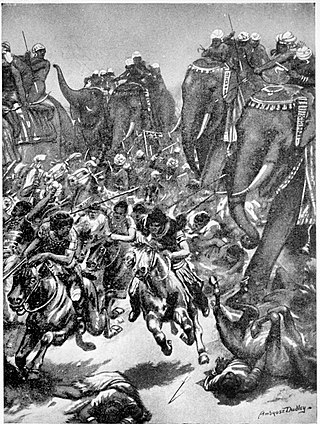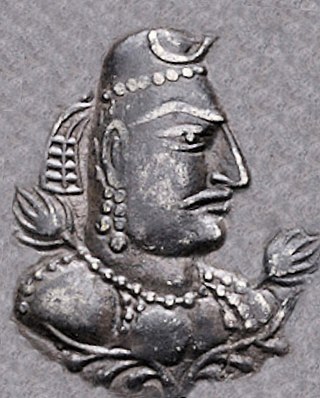A Hun is a member of the Huns, a confederation of nomadic tribes in Western Asia and Europe in late antiquity.
Contents
Hun or huns may also refer to:
A Hun is a member of the Huns, a confederation of nomadic tribes in Western Asia and Europe in late antiquity.
Hun or huns may also refer to:

The Huns were a nomadic people who lived in Central Asia, the Caucasus, and Eastern Europe between the 4th and 6th century AD. According to European tradition, they were first reported living east of the Volga River, in an area that was part of Scythia at the time; the Huns' arrival to Europe is associated with the migration westward of an Iranian people, the Alans. By 370 AD, the Huns had arrived on the Volga, and by 430, they had established a vast, if short-lived, dominion in Europe, conquering the Goths and many other Germanic peoples living outside of Roman borders and causing many others to flee into Roman territory.

The history of Turkmenistan traditionally began with the arrival of Indo-European Iranian tribes around 2000 BC. Early tribes were nomadic or semi-nomadic due to the arid conditions of the region, preventing widespread adoption of agriculture. The steppe culture in Central Asia was an extension of a larger Eurasian series of horse cultures which spanned the entire spectrum of language families, including the Indo-Europeans and Turko-Mongol groups. Some of the known early Iranian tribes included the Massagatae, the Scythians/Sakas, and early Soghdians, who were most likely precursors of the Khwarezmians. Turkmenistan was a passing point for numerous migrations and invasions by tribes, which gravitated towards the settled regions of the south, including ancient Mesopotamia, Elam, and the Indus Valley civilization.

The Bulgars were Turkic semi-nomadic warrior tribes that flourished in the Pontic–Caspian steppe and the Volga region during the 7th century. They became known as nomadic equestrians in the Volga-Ural region, but some researchers believe that their ethnic roots can be traced to Central Asia.
The Xiongnu were a tribal confederation of nomadic peoples who, according to ancient Chinese sources, inhabited the eastern Eurasian Steppe from the 3rd century BC to the late 1st century AD. Modu Chanyu, the supreme leader after 209 BC, founded the Xiongnu Empire.
The Hephthalites, sometimes called the White Huns, were a people who lived in Central Asia during the 5th to 8th centuries CE, part of the larger group of the Iranian Huns. They formed an empire, the Imperial Hephthalites, and were militarily important from 450 CE, when they defeated the Kidarites, to 560 CE, when combined forces from the First Turkic Khaganate and the Sasanian Empire defeated them. After 560 CE, they established "principalities" in the area of Tokharistan, under the suzerainty of the Western Turks and of the Sasanian Empire, before the Tokhara Yabghus took over in 625.

The Rouran Khaganate, also Juan-Juan Khaganate, was a tribal confederation and later state founded by a people of Proto-Mongolic Donghu origin. The Rouran supreme rulers used the title of "khagan", a popular title borrowed from the Xianbei. The Rouran Khaganate lasted from the late 4th century until the middle 6th century, when they were defeated by a Göktürk rebellion which subsequently led to the rise of the Turks in world history.
The "White Huns", also known as the White Hunas, in Iranian as the Spet Xyon and in Sanskrit as the Sveta-huna, were a sub-group of the Huna and/or Xionites. The White Huns are sometimes regarded as synonymous with the Hephthalites, but may have included other tribes as well. They are well known for their conquest and occupation of North India, particularly the Punjab region.

Yashodharman was a ruler of Malwa, in Central India, during the early part of the 6th century. He probably belonged to the Second Aulikara dynasty. He conquered much of the Indian subcontinent between c. 530-540 AD according to Mandsaur pillar inscription.

Xionites, Chionites, or Chionitae were a nomadic people in the Central Asian regions of Transoxiana and Bactria.
The Kidarites, or Kidara Huns, were a dynasty that ruled Bactria and adjoining parts of Central Asia and South Asia in the 4th and 5th centuries. The Kidarites belonged to a complex of peoples known collectively in India as the Huna, and in Europe as the Chionites, and may even be considered as identical to the Chionites. The 5th century Byzantine historian Priscus called them Kidarite Huns, or "Huns who are Kidarites". The Huna/Xionite tribes are often linked, albeit controversially, to the Huns who invaded Eastern Europe during a similar period. They are entirely different from the Hephthalites, who replaced them about a century later.
Scythia or Scythica, also known as Pontic Scythia, was a kingdom created by the Scythians during the 6th to 3rd centuries BC in the Pontic–Caspian steppe.

The Eurasian Steppe, also simply called the Great Steppe or the steppes, is the vast steppe ecoregion of Eurasia in the temperate grasslands, savannas and shrublands biome. It stretches through Hungary, Bulgaria, Romania, Moldova, Ukraine, southern Russia, Kazakhstan, Xinjiang, Mongolia and Manchuria, with one major exclave, the Pannonian steppe, located mostly in Hungary.

Nomadic empires, sometimes also called steppe empires, Central or Inner Asian empires, were the empires erected by the bow-wielding, horse-riding, nomadic people in the Eurasian Steppe, from classical antiquity (Scythia) to the early modern era (Dzungars). They are the most prominent example of non-sedentary polities.
Hunas or Huna was the name given by the ancient Indians to a group of Central Asian tribes who, via the Khyber Pass, entered the Indian subcontinent at the end of the 5th or early 6th century. The Hunas occupied areas as far south as Eran and Kausambi, greatly weakening the Gupta Empire. The Hunas were ultimately defeated by a coalition of Indian princes that included an Indian king Yasodharman and the Gupta emperor, Narasimhagupta. They defeated a Huna army and their ruler Mihirakula in 528 CE and drove them out of India. The Guptas are thought to have played only a minor role in this campaign.
The Nezak Huns, also Nezak Shahs, was a significant principality in the south of the Hindu Kush region of South Asia from circa 484 to 665 CE. Despite being traditionally identified as the last of the Hunnic states, their ethnicity remains disputed and speculative. The dynasty is primarily evidenced by coinage inscribing a characteristic water-buffalo-head crown and an eponymous legend.

The Alchon Huns, also known as the Alchono, Alxon, Alkhon, Alkhan, Alakhana, and Walxon, were a nomadic people who established states in Central Asia and South Asia during the 4th and 6th centuries CE. They were first mentioned as being located in Paropamisus, and later expanded south-east, into the Punjab and Central India, as far as Eran and Kausambi. The Alchon invasion of the Indian subcontinent eradicated the Kidarite Huns who had preceded them by about a century, and contributed to the fall of the Gupta Empire, in a sense bringing an end to Classical India.

The term Iranian Huns is sometimes used for a group of different tribes that lived in Central Asia, in the historical regions of Transoxiana, Bactria, Tokharistan, Kabul Valley, and Gandhara, overlapping with the modern-day Afghanistan, Tajikistan, Uzebekistan, Eastern Iran, Pakistan, and Northwest India, between the fourth and seventh centuries. They also threatened the Northeast borders of Sasanian Iran and forced the Shahs to lead many ill-documented campaigns against them.
The origin of the Huns and their relationship to other peoples identified in ancient sources as Iranian Huns such as the Xionites, the Alchon Huns, the Kidarites, the Hephthalites, the Nezaks, and the Huna, has been the subject of long-term scholarly controversy. In 1757, Joseph de Guignes first proposed that the Huns were identical to the Xiongnu. The thesis was then popularized by Edward Gibbon. Since that time scholars have debated the proposal on its linguistic, historical, and archaeological merits. In the mid-twentieth century, the connection was attacked by the Sinologist Otto J. Maenchen-Helfen and largely fell out of favor. Some recent scholarship has argued in favor of some form of link, and the theory returned to the mainstream, but remains disputed.

The Hephthalite silver bowl is a bowl discovered in the Swat region of Gandhara, Pakistan, and now in the British Museum. It dates from 460 to 479 CE, and the images represent two different Huna tribes, suggesting a period of peaceful coexistence between the Kidarites and the Alchons.